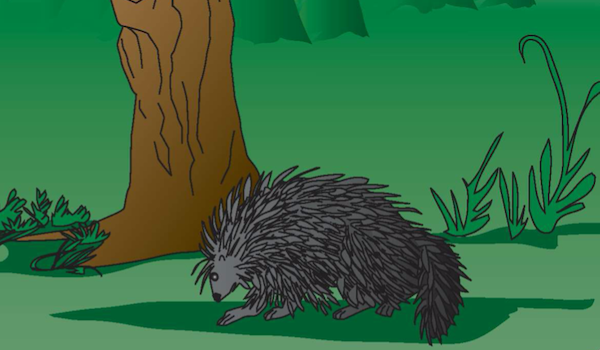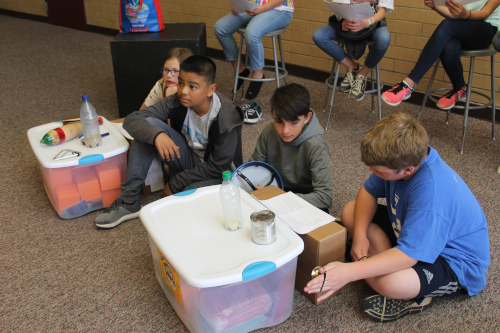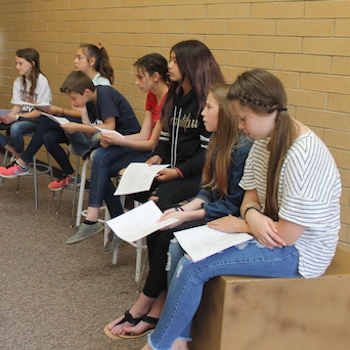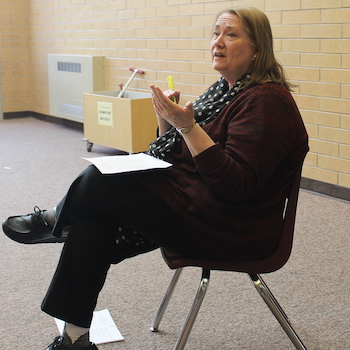SUBJECTS
GRADE
Show Results
The Greedy Porcupine

Lesson Summary
- Learn about Northwestern Shoshone storytelling.
- Participate in a reader’s theatre based on a Northwestern Shoshone tale.
- Connect the story to social and emotional skills.
Lesson Plan and Procedure
Lesson Key Facts
- Grade(s): 3, 4, 5, 6
- Subject(s): Drama, English Language Arts, Health, Social Studies, Native American, Tribe Approved
- Duration of lesson: 2-5 sessions, 45 minutes each
- Author(s): Patty Timbimboo-Madsen, Emily Soderborg, and Lisa Bean

The Northwestern Band of the Shoshone Nation selected this lesson content in answer to the question, “What would you like the students of Utah to know about you?” Patty Timbimboo-Madsen, the NWBSN History and Culture Specialist, represented the Northwestern Band of the Shoshone Nation in crafting the lesson to provide expertise, accuracy, and authenticity.
Before teaching this lesson, please explain to your students that there are many Native tribes in the United States and that this lesson specifically focuses on the Northwestern Band of the Shoshone Nation and does not represent other Native American groups. We hope that other Native tribes will respect the Northwestern Band of the Shoshone Nation's choice to share this aspect of their culture.
Before class make a copy of the reader’s theatre script, “The Greedy Porcupine,” for each student.
Session One: Storytelling
Teacher: By raise of hand, how many of you have had stories told to you? There are many reasons why stories, myths, legends, or fables are told. A fable is a short story, typically with animals as characters, that is used to teach a lesson.
Teacher: There are fables from all over the world. Today we are going to focus on a Northwestern Shoshone story. The Northwestern Band of the Shoshone Nation is a federally recognized tribe in Utah. Although the Northwestern Shoshone stories provide entertainment, a main reason they tell stories is to teach. Storytelling happens in the winter as elders in the tribe share the history and memories that make up the tribe's collective wisdom. The stories teach the children what is expected of them, where they fit in society, how to get along with others, and to be responsible members of their tribes. As the elders tell the stories, the audience is expected to listen attentively from beginning to end. If anyone is not paying attention or falls asleep, the story immediately stops. The children must listen carefully so they can internalize the concepts being taught as well as learn these stories to tell future generations.
Teacher: Because the Northwestern Shoshone language was traditionally an oral language, or not written down, stories became a way information was passed down. The Northwestern Shoshone were dramatically impacted by western expansion and had to learn how to adapt and thrive while still honoring and preserving their traditional cultural heritage. Storytelling is one way they have done this.
We have provided two different videos about Northwestern Shoshone story traditions. Please watch and decide which would be best for your class, or if time allows, share both as they each bring unique information and perspectives. Show video one and/or video two that explore storytelling and discuss the video.
Introducing Reader's Theatre
Teacher: We are going to explore a Northwestern Shoshone tale through reader’s theatre. Reader’s theatre scripts are simpler than a play because you don’t memorize your parts; you read from your script. There are many variations within types of reader’s theatre scripts. This particular reader’s theatre script adds a sound crew to emphasize actions, emotions, names or other elements within the script. Like most reader’s theatres, storytellers (narrators) cue the actions or dialogue to move the script forward. Let’s look at our script today and see what you notice.
Hand out scripts to the class. Give them time to look through the script and ask students to pay attention to what they notice.
 Teacher: As you looked through the script, did you see the cast list on the first page? It has four storytellers and then it lists four sound crew members. The sound crew helps tell the story by playing rhythm instruments such as a triangle or rattles. No matter which part you have, whether speaking or playing an instrument, you will need to track the script carefully, listen intently, and respond at the correct time.
Teacher: As you looked through the script, did you see the cast list on the first page? It has four storytellers and then it lists four sound crew members. The sound crew helps tell the story by playing rhythm instruments such as a triangle or rattles. No matter which part you have, whether speaking or playing an instrument, you will need to track the script carefully, listen intently, and respond at the correct time.
Teacher: The cast list identifies the specific characters in the story. Since this is a Northwestern Shoshone tale, the names are given in both Shoshone and English. The Shoshone language has several dialects depending on location and even how a family chooses to pronounce words. Let’s listen to Rios Pacheco, a member of the Northwestern Band of the Shoshone Nation, say each of these words in the Shoshone language. It is important that we listen carefully so we can pronounce the words as close to his pronunciation as possible.
Play the audio clips for each character. Have the students practice saying the Shoshone words after listening to each sound file. If your class would like to “dig deeper” into varying dialects, there are actually several pronunciations for the word, “porcupine” on the Shoshoni Language Project website. You will need to type the word “porcupine” into the search bar of the site.
Teacher: We also need to learn how to pronounce a Shoshone phrase used throughout the story. This phrase is “Hagai nus’nga” meaning “how are you?” It is a typical Shoshone greeting. Let’s listen to how to pronounce this phrase in Shoshone.
Practice saying the phrase as you listen to the recording. The Shoshone also use a shortened, more casual version of this greeting: “hagañ.”
Teacher: Next time we will start practicing reading our lines with expression.
 Note: You may want to have a “read through” with the whole class to help students familiarize themselves with the storyline, characters, and outline. Before the next session, consider having students select their top three choices to help you decide how to assign roles. You may need to assign more than one student to the same part so every student has a role. As a tip, if you do double-cast parts, do not have them say their lines in unison. Divide the line or lines so you can avoid the flat affect of most unison reading. Be willing to cast unexpectedly! Your “best” or highest readers are not automatically the best choice for leads. These students often tend to be predictably academic and not particularly comfortable in high profile lead roles. This is something of which to be aware–but don’t be rigid about it. Look for the students who can make sense of a line of dialogue and are willing and ready to be seen and heard. Cast these students in lead roles so they may model dynamic expression and fluency for fellow students and help ensure the success of the reader’s theatre. Very, very often, many of the lowest readers make the best leads because of the desire to be seen and heard. They tend to be brave and extroverted–great qualities for “leads.”
Note: You may want to have a “read through” with the whole class to help students familiarize themselves with the storyline, characters, and outline. Before the next session, consider having students select their top three choices to help you decide how to assign roles. You may need to assign more than one student to the same part so every student has a role. As a tip, if you do double-cast parts, do not have them say their lines in unison. Divide the line or lines so you can avoid the flat affect of most unison reading. Be willing to cast unexpectedly! Your “best” or highest readers are not automatically the best choice for leads. These students often tend to be predictably academic and not particularly comfortable in high profile lead roles. This is something of which to be aware–but don’t be rigid about it. Look for the students who can make sense of a line of dialogue and are willing and ready to be seen and heard. Cast these students in lead roles so they may model dynamic expression and fluency for fellow students and help ensure the success of the reader’s theatre. Very, very often, many of the lowest readers make the best leads because of the desire to be seen and heard. They tend to be brave and extroverted–great qualities for “leads.”
Extension
Tell one of Aesop’s fables, “The Peacock,” to the class, and then briefly discuss the fable and its moral.
Compare and contrast this fable with “The Greedy Porcupine.” The version of the story that the reader’s theatre script was adapted from is part of the Native American Indian Literacy Project storybook series. If using the booklet, it will need to be printed and assembled to be easily read.
 Session Two: Rehearsal and Performance
Session Two: Rehearsal and Performance
Once roles have been assigned, have students highlight their lines to be ready to practice with the class.
Review the Shoshone pronunciation and go through other possibly challenging vocabulary.
Teacher: As we read through the script today, make sure you're following along when it's not your turn to speak so that you are ready when it is your turn. Read the words as if you are talking. Use punctuation and context clues to help guide your expression and intonation as you read. I’m going to read one line from the script in multiple ways. Listen and tell me how my reading impacts the meaning of the words.
Take a sentence from the play and read it slowly. Read it again quickly. Read it quietly, then loudly. Finish by reading the sentence angrily.
Teacher: How does the way we read a line affect its meaning?
Gauge your class to see how much time you need to practice. See links in additional resources for other ideas for introducing and practicing reader’s theatre with your class. Read through the reader’s theatre script multiple times so all students have a chance to participate.
Reader’s theatre easily lends itself to creating an “informance” rather than a fully staged performance. An informance is an informal (and informing) exhibition or “share” created by students that focuses on process—thus is educational and casual, yet still engaging and entertaining. It is intended to showcase students' educational experience in the arts. An informance might involve an individual class performing for another grade-level or younger class, a class performing for their parents during school hours, or a small group informance within a single classroom. You could also record the reader’s theatre and share the recordings online. (See http://advancingartsleadership.com/node/67.)
Session Three: Connections
Note: This session is written separately but can be done simultaneously while rehearsing the reader’s theatre.
Teacher: What were some of your favorite parts of participating in this reader’s theatre? What were your favorite parts of the story, “The Greedy Porcupine?”
 Teacher: Do you remember how we said that stories like “The Greedy Porcupine” are told with the purpose of teaching children? The stories teach appropriate and inappropriate behaviors and they also provide examples of consequences of our choices. What are some of the things you thought were being taught in this story? What examples were shared through the characters’ actions?
Teacher: Do you remember how we said that stories like “The Greedy Porcupine” are told with the purpose of teaching children? The stories teach appropriate and inappropriate behaviors and they also provide examples of consequences of our choices. What are some of the things you thought were being taught in this story? What examples were shared through the characters’ actions?
Listen to students’ responses and help them clarify and reflect on their thinking, helping them to “dig deeper” using critical thinking strategies. “The Greedy Porcupine” is an excellent vehicle to discuss with students the following points:
- How positive and negative consequences of a decision can have short and/or long-term effects.
- How positive self-talk can help us overcome obstacles.
- How expressing gratitude and treating others with dignity and respect are social and emotional skills that can help us to be good members of our family and community.
- How we can develop skills to help us make healthy and safe choices.
Teacher: What are ways you have been working on developing these skills? What can we do to continue developing these skills?
Give students a piece of paper or have them write in their journal one goal they would like to set based on what they have learned from “The Greedy Porcupine.” Don't give them any additional parameters for setting this goal. After they have written their goal down, you may want to explain the value of setting SMART goals.
Teacher: To make sure your goals are clear and reachable each one should be:
- Specific (simple, sensible, significant)
- Measurable (meaningful, motivating)
- Achievable (agreed, attainable)
- Relevant (reasonable, realistic and resourced, results-based)
- Time bound (time-based, time limited, time/cost limited, timely, time-sensitive)
You can find additional talking points and examples in this article, S.M.A.R.T. Goals: How To Make Your Goals Achievable or in the lessons shared in additional resources.
Have students look at their goal while you go through each letter of the SMART goals acronym. Have them revise their goal to make it more possible to achieve.
Learning Objectives
- Experience aspects of Northwestern Shoshone culture.
- Understand how stories can be used to teach lessons.
- Participate in a reader’s theatre.
- Read with sufficient accuracy and fluency to support comprehension.
- Set a SMART goal.
Utah State Board of Education Standards
This lesson can be used to meet standards in many grades and subject areas. We will highlight one grade’s standards to give an example of application.
Grade 5 Drama
- Standard 5.T.CR.4: Define roles, identify responsibilities, and participate in group decision making.
- Standard 5.T.CR.5: Create character through physical movement, gesture, sound and/or speech and facial expression with age-appropriate outcomes.
- Standard 5.T.CR.7: Recognize that participating in the rehearsal process is necessary to refine and revise.
- Standard 5.T.P.5: Communicate meaning using the voice through volume, pitch, tone, rate, and clarity.
- Standard 5.T.CO.2: Read plays and stories from a variety of cultures and historical periods and identify the characters, setting, plot, theme, and conflict to better understand performance and design choices.
- Standard 5.T.CO.3: Investigate universal or common social issues and express them through a drama/theatre work.
Grade 5 Language Arts
- Standard 5.R.6: Determine the theme or main idea of a text including those from diverse cultures and how it is conveyed through particular details and summarize the text. (RL & RI)
- Standard 5.R.14: Compare stories in the same genre on their approaches to similar themes and topics. (RL)
- Standard 5.R.4: Read grade-level text* with accuracy and fluency to support comprehension. (RL & RI)
Grade 5 Health Education
- Strand 1, HEALTH FOUNDATIONS AND PROTECTIVE FACTORS OF HEALTHY SELF (HF): Students will apply their knowledge to develop social and emotional competence to make healthy and safe choices.
- Standard 5.HF.1: Define SMART goal and identify how SMART criteria improve the effectiveness of a goal.
- Standard 5.HF.2: Describe how the positive and negative consequences of a decision can have short and/or long-term effects.
- Standard 5.HF.3: Define and practice positive self-talk.
- Standard 5.HF.4: Demonstrate ways to express gratitude and treat others with dignity and respect.
Grade 5 Social Studies
- Standard 5.4.3: Summarize the impacts of forced relocation and assimilation on Native American people and how they have preserved their communities in the face of such adversity.
Equipment and Materials Needed
- One copy for each student of the reader’s theatre script, “The Greedy Porcupine”
- One of the following videos of a Northwestern Shoshone band member discussing storytelling
- Audio clips of Rios Pacheco, a Northwestern Shoshone, speaking the Shoshone words:
- Classroom instruments for the sound crew:
- Rattle, jinglers, guiro, triangle, wood block, tambourine, kazoo or flute, slide whistle, drum, tin can, finger cymbals
- Highlighters to mark scripts
- Access to Aesop’s fable, “The Peacock” (optional)
- “The Greedy Porcupine” from Utah’s Native American Indian Literacy Project (optional)
This Shoshone booklet is part of the Native American Indian Literacy Project storybook series for six main Utah Tribal Nations. There are five stories per Tribe, with a total of 30 booklets, plus an ABC book. The set of Indian Tribal stories may be utilized by elementary classroom teachers to (1) develop an understanding and appreciation of Native American culture and societal contributions (2) provide a genre of text for the application of reading strategies, and (3) facilitate the mastery of various Utah Core Content Curriculum objectives.
Additional Resources
This lesson was created thanks to a grant from the National Endowment for the Arts and the Utah Division of Arts & Museums.
- Explore more information about the Northwestern Band of the Shoshone Nation on their website.
- Coyote Steals Fire is a folktale illustrated by Northwestern Shoshone tribal children which also includes reference information in the back of the book. Shoshone Nation, Northwest Band, "Coyote Steals Fire" (2005). All USU Press Publications. 81. https://digitalcommons.usu.edu/usupress_pubs/81
- Reader’s Theatre Resources:
- Reader’s Theatre Tips for Optimal Results by Lisa Bean
http://www.hippohoorayforsecondgrade.com/2015/11/6-reasons-to-use-readers-theatre.html
- https://www.readingrockets.org/strategies/readers_theater
- https://www.weareteachers.com/8-steps-to-successful-classroom-readers-theater-2/
- Tips for Narrative Mime by Karla Huntsman
- Utilizing Traditional Native American Storytelling: https://www.ncbi.nlm.nih.gov/pmc/articles/PMC3098048/
- Resources for teaching SMART Goals:
Image References
Image 1: “The Greedy Porcupine” by Theresa Breznau https://digitallibrary.utah.gov/aw-server/rest/product/purl/USL/i/ca6686d9-d07c-47a6-971d-e802d84fc2d9
Image 2: The Northwestern Band of the Shoshone Nation
Images 3-6: Brenda Beyal
© Brigham Young University and the Northwestern Band of the Shoshone Nation

www.education.byu.edu/arts/lessons
 Download
Download